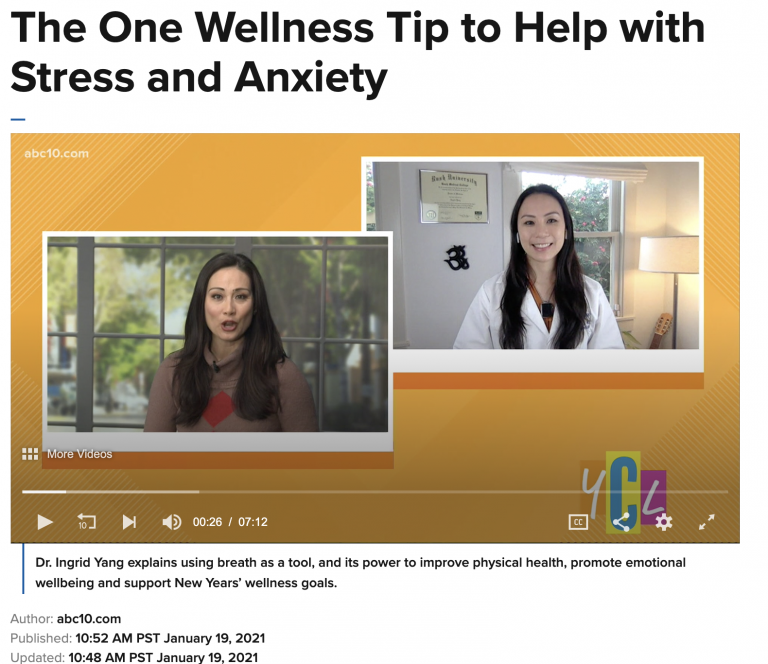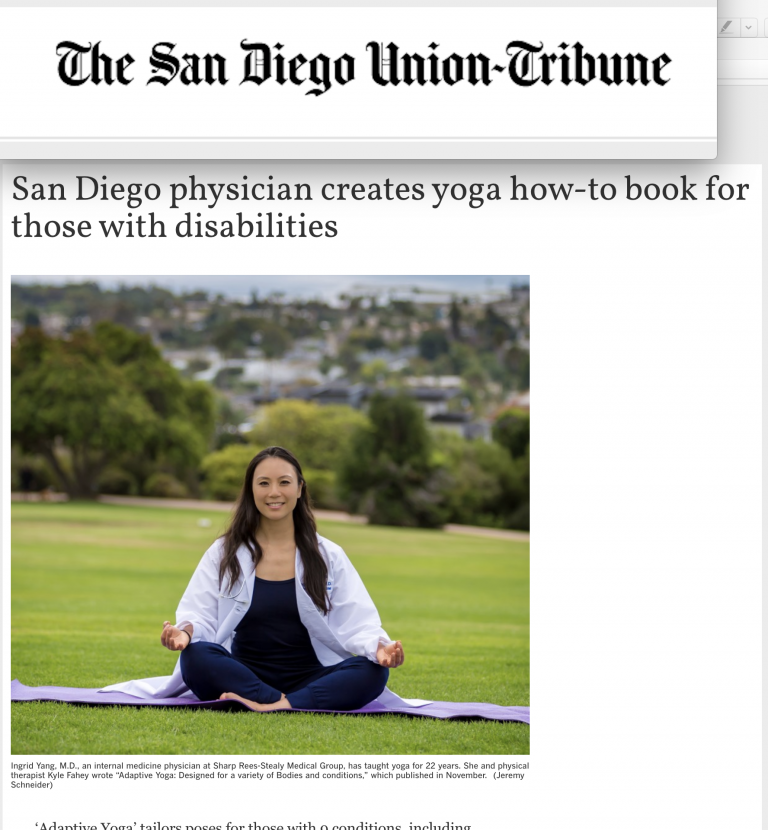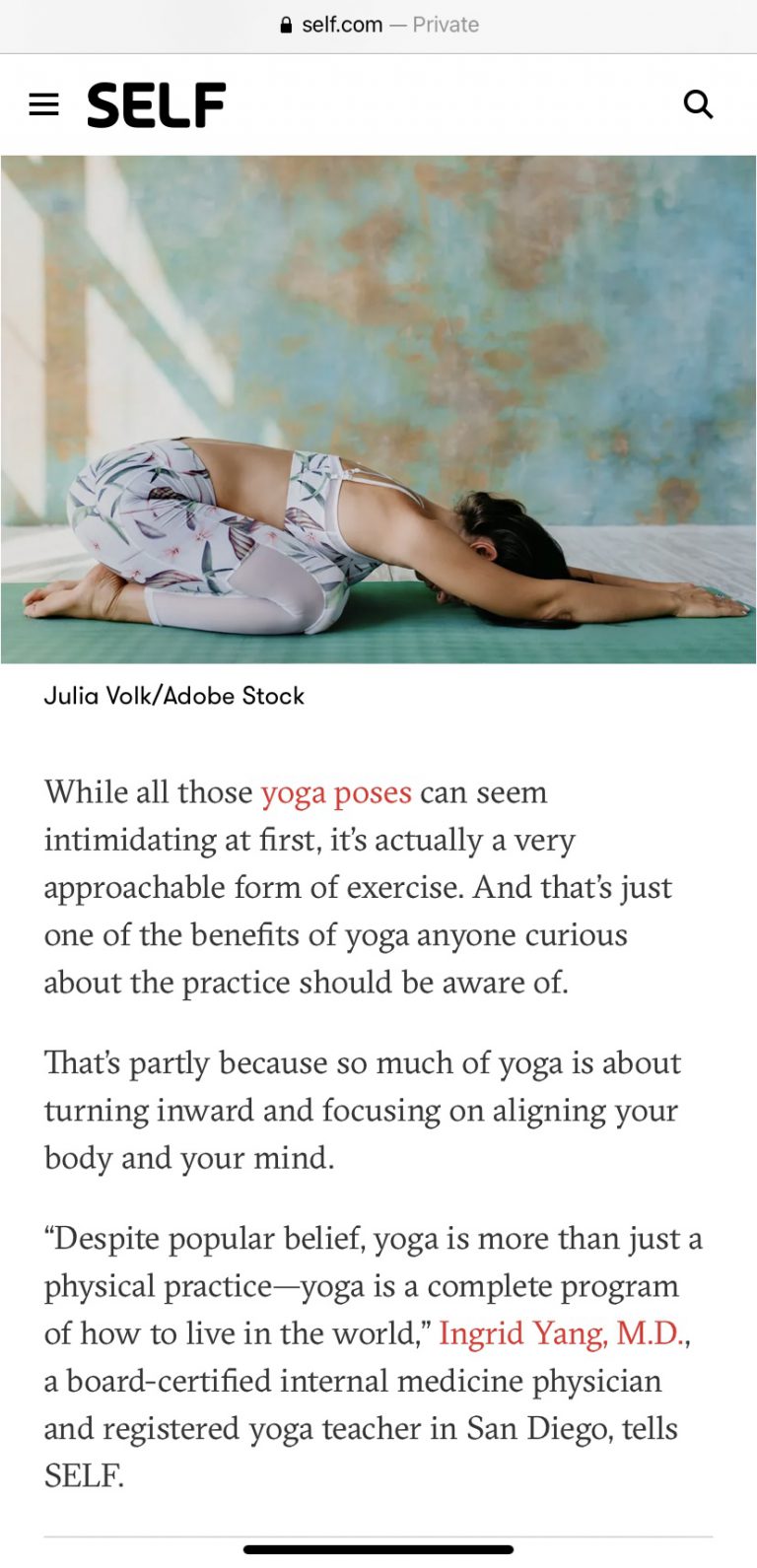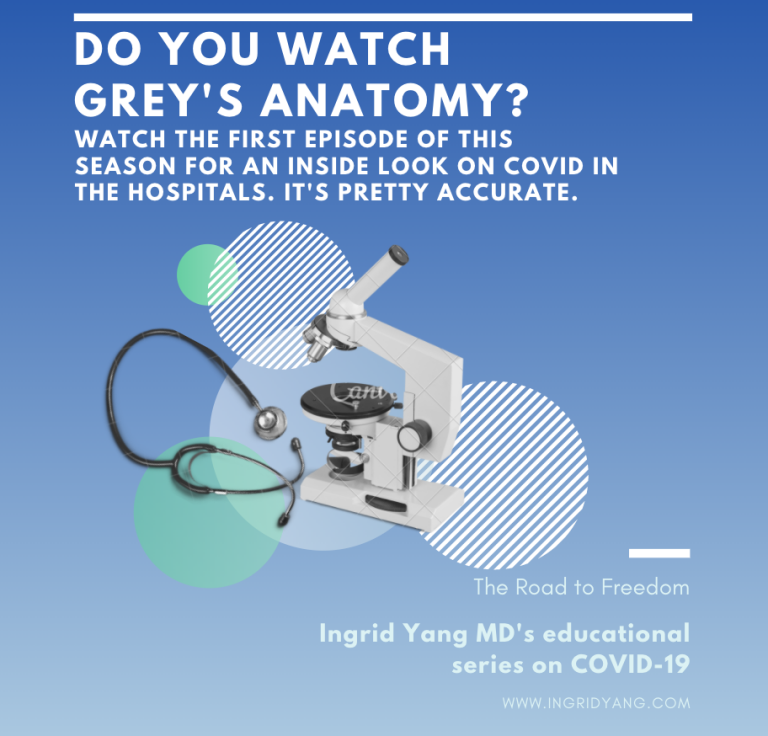Author: Ingrid Yang
Read Dr. Yang’s article in Yoga Therapy Today on yoga therapy for those recovering from COVID-19
This article was originally published in Yoga Therapy Today Winter Edition 2021 in January of 2021. https://www.iayt.org/general/custom.asp?page=YTTCurrentIssue
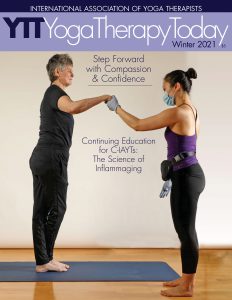
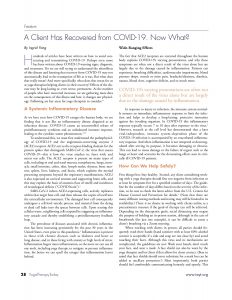
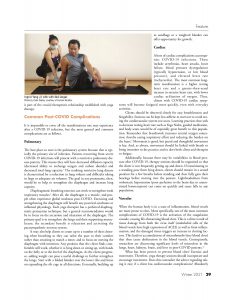
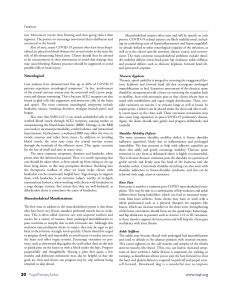

Dr. Yang shares her #1 Wellness tip for 2021 with ABC 10 California Life
Dr. Yang shares her #1 Wellness tip for 2021 with ABC 10 California Life. Watch the news segment here:
Link to watch here.
Everything you need to know about the COVID-19 Vaccine
I’ve gotten a lot of questions about the COVID-19 vaccine recently. “Should I get it if I’m pregnant?” “What if I have an allergy to bee stings?” “What if I’ve already been infected with COVID-19?” “What side effects have you had?” And the most common one: “If you get the vaccine and have immunity from the disease, can you still transmit it?” (Hint: most likely not).
So here is your best resource for your answers (click here for full article from NEJM)

In short:
Should I get it if I’m pregnant? So far, there have been no reports of the vaccine injuring fetuses, however, thus far there have been no large studies on this. On a personal level, I have had friends get the vaccine who are pregnant, and have since had their babies and all is well.
What if I have an allergy to bee stings? Thus far, there does not appear to be anaphylaxis responses to the vaccine for people that have anaphylactic responses to bee stings. The best way to gauge your allergic response is if you have had allergies to vaccines in the past.
What if I have already been infected with COVID-19? Those who have active infection to COVID-19 should wait to get their vaccine (because it will be less effective). But if you have had the infection in the past, it is still recommended that you get the vaccine.
What side effects did you have? I had a sore arm for just done day with each shot (I’ve gotten the first and second dose of the Pfizer vaccine), and a mild headache after the second shot, which resolved after a day.
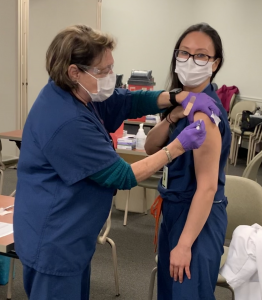
Can you still transmit the disease if you have been fully vaccinated? Probably not (after you have gained the full immunity, i.e. at least 1 week after your 2nd dose). For one, the virus is very unstable outside of the body. Prevention of disease also equates to prevention of infection. However, as this is still being studied, it is still recommended that you take all precautions as you did before such as hand washing, social distancing, and mask-wearing.
Remember, the vaccine is not just 95% effective in preventing COVID-19 infection, but close to 100% effective in prevent serious, life-threatening illness with COVID-19! This downgrades it to less deadly than influenza, and saves so many lives!
Click on this link to read more from the infectious disease expert, Dr Paul Sax in the New England Journal of Medicine.
The opinions expressed on this page and by the owner of this website are published for educational and informational purposes only, and are not intended as a diagnosis, treatment or as a substitute for professional medical advice, diagnosis and treatment.
Portugal Yoga Retreat- September 2021
Join me for the retreat of a lifetime in Portugal’s beautiful Algarve this September 9-13, 2021.






Thursday, September 9 – Monday, September 13, 2021
Join Ingrid for an inspiring and rejuvenating yoga retreat in Portugal’s Algarve!
With 300 days of sunshine every year, this paradise in Southern Portugal is the perfect place to unwind, relax, and re-energize. Held at the exquisite retreat center, Casa Fuzetta, the space is designed to nourish and support your soul. Reconnect with yourself on this 5-day retreat, which will start every morning with a mindfulness practice in the meditation hall. Then, enjoy a dynamic yoga class designed to warm the chakras and advance, so all yoga levels are welcome. The day will end with a candlelit restorative, yin or reiki class and the opportunity to indulge in a personal treatment offered throughout your stay. The retreat is designed to promote ultimate relaxation and rejuvenation while surrounded by beauty, offering you the space to find grace and rest.
What’s included:
- Two yoga classes/day ranging from vinyasa in the mornings, and deep stretch, restorative or yin with reiki in the evenings.
- Daily mindfulness/meditation class.
- Full and exclusive access to this luxurious retreat center in the courtyard where you can listen to the fountain, soak in your clawfoot bathtub, or enjoy a world-class massage.
- Fully-stocked luxurious rooms with the highest quality amenities, soaps and bathrobes, including claw-foot bathtubs, chandeliers, velvet chaise lounges, antique furniture, water bottles, and yoga mats.
- Planned day-trip to the nearby remote islands (just a 30-minute boat ride)
- Plenty of time to relax and find a hiding space in this exquisite home, snuggle up in the Library with your favorite book, lay back in the glorious sunshine decks, or take a dip in the roof top pool as the sun sets.
- Two daily meals (large brunch and plated dinner) to nourish your body with delicious food curated by our own private Portuguese chef. *All meals are organic and customizable to all dietary needs (vegan, gluten free, etc.).
- Guided strolls through the lovely streets of the charming Portuguese villages to explore the handmade ceramics well-known from this region.
- Recommendations on where to find wander into a café to listen to Fado, the expressive Portuguese music.
About Casa Fuzetta:
Casa Fuzetta is a beautiful, renovated historic home located in the heart of Portugal’s Algarve. Originally, a classical residence, it was lovingly restored over three years with restoration completion in 2016. Local craftsmen and artisans were gathered to restore the property to preserve its architectural heritage and imbue it with contemporary design and comfort- including a spectacular rooftop pool! The design is truly exquisite, with a palette of natural elements– white, stone, wood and linens, creating a space where everyone feels at ease the moment they walk through the door. The first level centers around a limestone courtyard with a fountain and lavish green plants next to a stunning library space where yoga classes will be held. The heart of the second level includes a state-of-the-art kitchen for all to gather, and a magnificent stained-glass meditation space. The third floor holds another outdoor yoga space and the rooftop pool. Each guest room includes sumptuous bathrobes with highest quality soaps and shampoos. The beds have the highest quality sheets and pillows for a truly luxurious experience. The rooms are decorated with velvet chaise lounges, claw-footed bathtubs, chandeliers and real-wood antique furniture. The entire space is designed to allow you to relax in comfort and luxury. Some come, enjoy, relax, and feel good
.
About the Algarve:
The Algarve is the beautiful southern coastline of Portugal. It is a region blessed with stunning beaches, picturesque fishing towns and a glorious climate, all of which combine to create the perfect vacation destination. The region is very safe, English is widely spoken, and the Portuguese are welcoming and hospitable in the little
towns of the Algarve. It is a destination that attracts many Northern Europeans, and a still somewhat undiscovered (so a less crowded and more affordable) destination in Europe. Soaring cliffs, sea caves, golden beaches, scalloped bays and sandy islands offers a paradise for surfers, travelers and vacation seekers from all over the world. It is the perfect place to relax, enjoy the beauty of the ocean and engage in European old-world charm.
Pricing:
5 days /4 nights, accommodations, yoga and gourmet meals included. All prices in USD.
-King bed, single occupancy: $2150pp
-King bed, double occupancy: $1500pp (must be booked simultaneously with another guest for a total of $3000 for the room)
-Twin bed, shared room, double occupancy: $1500pp (must be booked simultaneously with another guest for a total of $3000 for the room)






San Diego Union Tribune Features Dr. Yang and Adaptive Yoga
This article was originally published in the San Diego Union Tribune on January 5, 2021
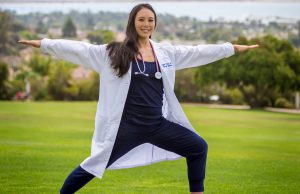
‘Adaptive Yoga’ tailors poses for those with 9 conditions, including Parkinson’s, arthritis, stroke and multiple sclerosis
A long and varied path led Ingrid Yang to her multifaceted career. An internal medical physician with the Sharp Rees-Stealy Medical Group, Yang, 41, also has been a yoga teacher for 22 years. Because her residencies included physical therapy and rehabilitation, it was a natural progression to develop yoga poses specifically designed for people with disabilities.
Yang collaborated with physical therapist Kyle Fahey to write the book, “Adaptive Yoga: Designed for a variety of bodies and conditions,” published in November.
“Yoga is intrinsically modifiable,” Yang said. “There’s a huge variety: hardcore hot yoga, laughing yoga, restorative yoga. And yoga offers so many ways to modify, including blocks, bolsters and walls.
“People with chronic medical conditions have an increased risk of depression and anxiety. Yoga is good at decreasing anxiety attacks and depressive responses. Yoga is a tool that’s not pharmaceutical. Using breath is important. When we deepen our breath, we can release frustration and let go.”
The book offers yoga adaptations for nine disabilities: low back pain; osteoarthritis of the hip and knee; rheumatoid arthritis; lower limb amputation; spinal cord injury; Parkinson’s disease; stroke; multiple sclerosis; and cerebral palsy.
These disabilities are fairly common, and Yang has worked closely with patients who have them. Many gave her feedback as she and Fahey were formulating the adaptations.
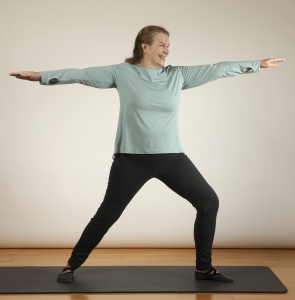
“Adaptive Yoga” was written for physical therapists and yoga teachers, and for people who have one or more of those conditions. It offers clear instructions and explanations in straightforward language, and each pose is accompanied by an illustrative photo.
But you won’t see supermodels demonstrating Warrior II or downward-facing dog.
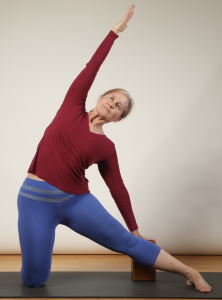
“When we think about yoga, we envision the perfect gymnast doing unbelievable positions. And we think: ‘I can’t do that!’ ” said Yang, who tends to acutely ill patients at Sharp Memorial Hospital in Kearny Mesa.
“Every single one of the models in the book has the corresponding disability. That was important to me. What’s the point in me showing an amputee how to do a pose? Working with the models and with my students taught me how to actually write this book.”

‘An incredible feeling’
Nikki Armstrong was one of the first participants in sessions led by Yang and Fahey as they developed an adaptive yoga program at the Shirley Ryan AbilityLab in Chicago.
Armstrong, who had practiced yoga since high school, attended a cousin’s wedding in October 2018. A day or two later, the then-24-year-old woke up with what she described as “zombie arms.”
Within a few days, she was unable to walk or swallow.
Armstrong was eventually diagnosed with Guillain-Barré Syndrome (GBS), a rare autoimmune disease in which the body’s immune system attacks the nerves. It can result in complete paralysis.
She began to recover through a blood exchange procedure, but the impact of her paralysis was severe. She soon began physical therapy in Chicago, even while on a ventilator.
“That’s how I met Ingrid Yang,” said Armstrong, whose voice wavered from emotion as she recounted her story. “I remember going to class in my wheelchair. I was so touched by the fact that I could still do movement, I could do yoga, even with these limitations. It was an incredible feeling.”
Now 26, Armstrong works full time and can walk, run, and practice yoga like she did before contracting GBS. Besides numbness in her feet and occasional balance issues, she feels back to her former self.
“Ingrid has medical knowledge and incredible expertise in all things yoga, Armstrong said. “I’ve never been in a class so alive — everyone was excited about the possibilities of adaptive yoga. It’s not very well known and I’m glad the book will spread the word.”
‘Truly accessible for all’
Publishing “Adaptive Yoga” now was not ideal. Yang said the initial plan was for her to do book signings and demonstrations at yoga studios across the country.
She immediately put those plans on hold because of the pandemic. She’s trying to promote the book, available on Amazon, through social media and other safe methods.
“I think this book is important,” Yang said. “I didn’t want to write something no one would read. But I want to act in a manner that is responsible. The consequences of actions that would have seemed so benign are so serious now.”
In 2017, Yang transferred from Chicago’s Northwestern University to do her residency in internal medicine at Scripps Green Hospital. Since 2018 she has combined taking care of patients at Sharp Memorial with writing the book. Until the pandemic hit, she was also presenting yoga demonstrations worldwide.
Soon she will be offering livestream adaptive-yoga training seminars, including one on Jan. 16 for yoga teachers and medical professionals.
People who fall outside of those realms may benefit from reading “Adaptive Yoga.” Yang encourages seeking out a teacher or guide to help.
“If you may not be ready to do that, I’d recommend reading the chapter for your specific condition in its entirety. Then, determine by your own good judgment what poses and sequences resonate with you,” she said.
“There may be certain postures that you have been doing naturally without knowing they are yoga. Better yet, there may be poses that you aspire to that you can discuss with your physical therapist or yoga teacher.
“The book was written in plain terms to make it truly accessible for all. No yoga background is necessary, just a curious mind and a belief in yourself.”
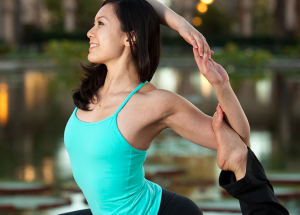
Dr. Ingrid Yang’s thoughts on breathing
- “Dozens of breathing techniques are available. Practice what feels comfortable for you. Some techniques utilize slow, diaphragmatic breathing, and others use a more rapid, energetic breath.”
- “There is no one-size-fits-all. Once you have practiced a breathing technique and mastered it, you can start to explore others recommended in ‘Adaptive Yoga.’ ”
- “Be mindful of your breath.”
- “This mindfulness of the breath in each posture is the essence of yoga and a breathing technique itself.”
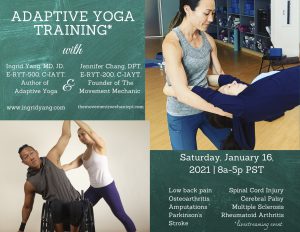
Adaptive yoga training
A livestream training for yoga teachers and medical professionals
Instructors: Ingrid Yang, author of “Adaptive Yoga,” and Jennifer Chang, founder of The Movement Mechanic
When: Jan. 16, 8 a.m. to 5 p.m.
Cost: $425
For more information: ingridyang.com/retreats-trainings/adaptive-yoga-training
Wood is a freelance writer.
Self Magazine feature: Dr. Yang discusses the benefits of Yoga
This article was originally published in Self Magazine.
While all those yoga poses can seem intimidating at first, it’s actually a very approachable form of exercise. And that’s just one of the benefits of yoga anyone curious about the practice should be aware of.
That’s partly because so much of yoga is about turning inward and focusing on aligning your body and your mind.
“Despite popular belief, yoga is more than just a physical practice—yoga is a complete program of how to live in the world,” Ingrid Yang, M.D., a board-certified internal medicine physician and registered yoga teacher in San Diego, tells SELF.
In fact, she says, it all comes down to its definition: Yoga is derived from the Sanskrit word yuj, which means to yoke or bind, she says. “Understanding the definition helps us understand that the experience of yoga is one of connection, referring to the union of our own body and mind. In this manner, yoga is an organic technique of helping us keep our mind and body in the same place at the same time.”
But there’s more to yoga too—here’s what you need to know about the mentally grounding form of exercise.
What is yoga?
According to the National Center for Complementary and Integrative Health, yoga is an ancient practice based on the Indian philosophy of promoting physical and mental health that began more than 4,000 years ago.
What makes yoga particularly unique is that it combines the mindful benefits of meditation with physical poses, also known as asanas. So you’re not just training your muscles to handle life’s challenges in the way you move through the poses, but you’re also using the power of your breath and your mind to keep you grounded.
The poses in yoga are designed to strengthen and align your muscles and bones, which helps relieve tension in your body and mind, Dr. Yang explains.
“We become sensitized to the feelings that arise—both physical and emotional—during a yoga session and develop an awareness of the thoughts in our mind. When we do this simultaneously, our heart opens and our mind calms down, and we live our lives with more grace and positivity in a very natural and easy manner,” Dr. Yang says.
What beginners should know about starting yoga
There are many different styles of yoga, including hatha, vinyasa, Ashtanga, and even hot yoga such as Bikram. But if you’re new to the practice, a hatha class may be a solid start, since it’s gentle and teaches you basic poses that are the foundation for other forms of yoga, Keisha Courtney, a registered yoga teacher based in Oakland and founder of The Driven Yogi, a continuing education program for yoga instructors to become safer and more effective and inclusive teachers, tells SELF.
“Hatha tends to move at a slower pace, and poses get broken down in a little more detail,” Amanda Tripp, a certified yoga teacher from The Driven Yogi community, says. Those a little more experienced may want to try a beginner vinyasa or Ashtanga class, which tend to be more vigorous and quick paced. Hot yoga is done in a heated room, which makes the practice more challenging, so it’s generally another great option for more seasoned yogis (in non-pandemic times, at least).
If you’re not quite sure where to start, taking classes to familiarize yourself with the different kinds of practices can be a great option. And even though most in-person options aren’t available right now due to the COVID-19 pandemic, you can find plenty of yoga tutorials and classes online.
Start with a simple online search like “yoga for beginners,” says Courtney. This will introduce you to tons of different kinds of practices, some just a few minutes and others as long as an hour. “Either way, the class should get you familiar with basic poses of yoga. Once you are comfortable with the basics, you can add more and more to your routine,” she says.
Tripp says a beginner program that runs six to eight weeks could be a helpful way to learn foundational yoga poses step by step. You’ll not only learn common Sanskrit terms and what they mean, but you’ll also become familiar with breathing techniques and the use of props like blocks and straps.
If you’re able to book a virtual private session, Dr. Yang also suggests working one-on-one with a certified yoga teacher to help tailor the poses to your needs and goals. “A yoga teacher is trained to notice imbalances in your body and make recommendations on where to find more balance and strength,” she explains.
As for how frequently you should practice yoga? There isn’t one answer: It depends largely on your fitness schedule and your goals, Courtney says. If your goal is to get better at yoga, practicing it two or three times a week as part of your workout routine might be helpful, says Dr. Yang—though you can see significant improvements in practicing it just once a week.
But if you’re not sold on devoting a solid chunk of your workout time to yoga, you can also easily incorporate it into your workout routine as a warm-up or cooldown. It’s especially beneficial during the latter, since it activates your parasympathetic nervous system, which is responsible for slowing down your heart rate and promoting relaxation.
That’s just one of the benefits of yoga you can experience by adding it to your routine. Here are some other advantages of the ancient form of exercise you should know.
Physical Benefits of Yoga
If you work at a desk (or couch) all day, you may be experiencing some low back, shoulder, and neck pain due to poor posture. “Yoga improves posture, which can prevent low-back pain, as well as shoulder and neck pain,” Dr. Yang says.
Yoga promotes low-back pain relief in two ways: First, the meditation techniques used in yoga encourages relaxation from the physical discomfort related to chronic low-back pain, according to the National Institutes of Health (NIH). Then there are the poses themselves: The physical practice builds core strength and stability—something important for posture too—which is one of the main lines of treatment for addressing low-back pain.
In fact, a 2016 review of 27 studies published in the Journal of Rheumatology and Orthopedics concluded that yoga appears to be better than the usual standard of care in reducing people’s perceptions of the severity of chronic low-back pain, or how bothered they are by their discomfort.
Some of the best yoga poses for lower back pain include Child’s pose, Cat/Cow, Downward Facing Dog, and Standing Forward Bend, as SELF reported previously.
When you ground your body to hold all the poses, you recruit a bunch of both big and small muscles. Yoga also focuses on proper form—you need to activate the right muscles—which creates a better understanding of how your muscles, joints, and tissues work together. This can help ensure you move safely, Courtney says.
“Yoga is an alignment-based practice. We learn to stack and align joints to most efficiently utilize our muscles and release active energy,” Dr. Yang says. “More importantly, it builds awareness in our bodies so that we can participate in our lives with more physical freedom and less discomfort.”
For example, when you’re doing Tree pose, which involves balancing on one leg, you’re actively firing your inner thighs, quads, and core to help you stand upright and avoid falling over. This also makes you more aware of the placement of your ankle, hips, and shoulder joints, and how they are supported by tendons and tissues to help you maintain alignment and balance.
When you move—like by doing some yoga stretches during the day—your heart pumps more oxygen-rich blood to the muscles and organs in your body. This can help reduce fatigue and tiredness, according to the International Sports Science Association.
According to a small August 2017 study in the Journal of Science in Medicine in Sport, practicing Bikram yoga is linked to better energy and stress levels. When sedentary and chronically stressed adults followed a 16-week Bikram yoga program, they reported improved perceived stress, energy, and fatigue levels and better overall health-related quality of life. Researchers also found similar fatigue-fighting benefits to hatha yoga.
Inversion poses—where your heart is at a higher level than your head—may be particularly helpful at increasing energy, says Courtney. These include poses like Forward Fold and Downward Facing Dog.
Balancing yoga poses, such as Warrior III, Chair, Eagle, Tree, and Crow, help challenge your stability, since removing a base of support (say, by standing on one leg) requires you to activate certain stabilizing muscles. This helps improve your balance, which is particularly important as you get older.
As people age, they tend to lose mobility due to inactivity, arthritis, and other age-related disease. But research shows that doing some yoga-based exercises is associated with better balance and mobility in adults over the age of 60.
Better balance can mean a reduction in injury risk and an improvement in athletic performance, says Dr. Yang. That’s because when you have better balance, you have better awareness to fire up the right muscles to help you maintain stability. Think of doing a single-leg deadlift: If you’re able to fire up the correct muscles—your core, lats, and the glutes on your working leg—you’ll be able to complete the move more efficiently, helping you build strength.
If you’re new to exercise—or are easing back into a workout routine after a break—vigorous exercise may not seem to be the most appealing. That’s why many people looking to get started exercising turn to yoga: It’s a low-impact workout that’s easy on the joints, is accessible for most fitness levels, and requires no special equipment.
This all makes yoga a type of exercise you’re more likely to stick with and make a regular practice. In fact, according to a small study of physically inactive adults published in Alternative Therapies in Health & Medicine, taking yoga classes twice a week significantly improved adherence to physical activity, something that persisted even after the participants stopped taking classes as part of the study.
A 2014 review in the European Journal of Preventive Cardiology concluded that yoga has shown some promising benefits for improving cardiovascular disease risk, by lowering heart rate, blood pressure, and even cholesterol. It’s likely due to both the physical aspects of yoga as well as the focus on breath.
That’s because yoga trains the vagus nerve, which is the main nerve that directs the parasympathetic nervous system—the part of the nervous system responsible for lowering heart rate and promoting relaxation—to be more responsive to your breath, Dr. Yang says. “The very function of your heart may improve.”
Follow a yoga flow for as little as five minutes, and you’ll realize just how calming and relaxing it can be to sync movement and breath. As you deepen the stretch in each pose, you’ll rely on your breath to hold them with proper form.
“Yoga uses a practice called diaphragmatic breathing, where you focus on expanding the diaphragm when breathing. This focus tones the diaphragmatic muscles to become stronger, and thus the lungs are able to take in more capacity and become stronger themselves,” Dr. Yang explains. “The vagus nerve actually runs through the diaphragm, and the movement of the diaphragm around the vagus nerve stimulates the parasympathetic response, allowing the rest-and-digest response to be more accessible to us.”
This type of breathing can easily be translated to something you use in everyday life during stressful situations or during other forms of exercise.
While yoga isn’t exactly known for building strength the same way that weight lifting is, moving through poses will essentially give you the same benefits of doing bodyweight exercises. For example, holding Chair pose is similar to doing a squat; moving through chaturanga involves performing a Plank and push-up.
“The poses we practice may look easy, but holding them for longer periods of time is actually a workout in itself,” Courtney says. With more active asana practices, like vinyasa or Ashtanga, you may experience the strength-building benefits even faster.
Depending on the style of yoga you’re practicing, the muscle-building benefit is mostly due to the isometric holds. Isometric exercises, such as the Plank, involve contracting a muscle or muscle group without actually moving the joint surrounding the muscle. This makes this form of exercise ideal for people who are recovering from an injury or experiencing joint issues, according to the Mayo Clinic. Although isometric exercises aren’t ideal for growing bigger muscles, they are essential for improving muscular endurance and performance.
Flexibility is the measure of how much your muscles are able to extend or lengthen, according to the American College of Sports Medicine. Yoga helps improve your flexibility by helping your muscles relax through gentle stretching, Tripp says.
With more flexibility, you can boost your overall fitness performance. “For a muscle to contract fully, it has to be able to lengthen fully. Flexibility training can help you access your joints’ full range of motion, enabling your muscles to work more effectively,” Tripp explains. “Limited range of motion can limit your abilities in certain movements.”
For example, limited ankle range of motion can dramatically limit your ability to squat, Tripp says. But if you can squat with full range of motion (parallel or below parallel), you can recruit your glute muscles more effectively, allowing you to load more resistance which translates to bigger strength gains.
Better flexibility can also mean a lower risk of injury. For example, chronically tight pectoral muscles (the muscles in your chest) can cause your shoulders to round forward, moving your shoulder out of neutral positioning, Tripp says. If you load weight onto a joint that isn’t aligned optimally, like when you’re chest pressing during an upper-body workout, you risk injury.
With better breathing and relaxation, yoga can help you get more quality snooze time at night. According to a meta-analysis of 19 previously published studies on women with sleep problems, practicing yoga was linked to higher scores on measures of sleep quality. And the more time spent on yoga, the more robust the benefits were.
If you’re practicing later at night, though, you may want to stay away from more vigorous forms of yoga, which may keep you awake. These bedtime stretches can help prepare you for a good night’s sleep.
Mental Benefits of Yoga
Of course, no type of exercise can “cure” mental health conditions like anxiety and depression—and it can be annoying to be told to “just work out” if you’re dealing with them. But the combination of gentle movement and focused breathing may have some mental health benefits, meaning yoga may play a role in how you feel if you experience those conditions.
In fact, a study of 48 office employees published in the Scandinavian Journal of Work, Environment, & Health found that after six weeks of yoga, the workers reported feeling less stress in the workplace. They also reported feeling less anxious, confused, depressed, tired, and unsure than their coworkers who didn’t participate in yoga.
And a small separate study published in the Journal of Complementary and Alternative Medicine discovered that those who participated in yoga three times a week for 12 weeks reported greater decreases in anxiety than those who walked for the same amount of time. The researchers theorize that the combination of focused breathing and yoga poses may stimulate the vagus nerve, triggering the parasympathetic nervous system and tamping down anxiety.
Whether you’re doing a few Cat-Cow flows or lying down in Savasana, yoga turns on your relaxation response. By focusing on your breathing and releasing tension in your muscles and joints through the poses, you’ll usher in a sense of calm.
“Relaxation is a valuable skill that you can train,” Tripp says. “Yoga is a movement modality that helps to quiet your mind. In yoga, you might focus your attention on moving with precision or timing your movement with your breath in order to keep your mind focused on what is happening now. It is a great way to get out of your head and into your body.”
After a tough workout, cooling down with a quick yoga stretch could help loosen up your muscles and ease your mind out of that high-intensity mindset. Courtney suggests following a box breathing technique to boost those benefits while stretching afterward.
“Inhale in for a count of four, hold for a count of four, exhale for a count of four, and then hold again for a count of four. Repeat this technique for three to four rounds while in a stretch,” she says. “You may notice a balancing of your energy and possibly a release of some anxiety simply from tuning into your breath.”
Remember, by focusing on your breath, you’re activating your parasympathetic nervous system, which reminds your body and mind that you’re done with your workout—and that it’s now time to relax.
Holding a yoga pose correctly takes a combination of concentration and endurance: You need focus to move your body into the pose, and stamina to keep it there for that set amount of time. This combination not only helps your yoga performance, but it can also help you sharpen your mental focus on other stressful situations in your everyday life, too, says Courtney.
“When you practice yoga, you hold poses for a period of time. That takes focus and constantly telling your mind that your body is okay,” Courtney says. “With a consistent practice, you’ll be able to take these skills off of the mat and they can help you in times of stress.”
While yoga activates your body’s relaxation response, it isn’t always a walk in the park. Performing twists, binds, and inversions in yoga poses can help you learn how to sit with discomfort and embrace it. But challenging as they may be, there’s an end to each pose, and a new one that comes behind it.
For example, Dr. Yang says she likes to practice vinyasa because she believes it best emulates life.
“You never hold any posture for too long; therefore, if you dislike a posture, you know you’ll get to move on soon enough. And if you love a posture, you learn to let it go because you cannot dwell in only the things you like—the next posture will be called out soon enough,” she explains. “Thus, it teaches us the natural rhythms of life. When you are uncomfortable, you learn to sit with discomfort because you know it will pass. When you are joyful and want to hold onto something, you learn to let it go because things inevitably change.”
Japanese Souffle Pancakes
These are some of the best pancakes I’ve had in a while, and make for a lovely, light breakfast. Totally worth the effort of whipping the egg whites! I adapted this recipe from many different sources including NY Times and Kirbie’s Cravings. Enjoy!
- 6tbsp cake flour
- ¼ cup almond milk
- 1tsp baking powder
- 1 tspvanilla extract
- 6tbsp caster’s white sugar
- 4 egg whites and 2 egg yolks (separated)
- 1 TBSP lemon juice
- In a stand mixer with the whisk attachment, whisk chilled egg whites (4) and lemon juice until frothy (approx. 1 min). Then add 5 TBSP caster’s sugar (1 TBSP at a time). When all the sugar is in, increase to highest speed until stiff peaks form. (About 3-4 minutes.) Your meringue should be able to hold its form and if you turn the mixing bowl upside down, the meringue will not slide out.
- In a separate bowl, beat the 2 egg yolks, adding baking powder, 1 TBSP remaining caster’s sugar, baking powder, vanilla extract, almond milk and cake flour. Whisk until well combined.
- Heat a lidded nonstick skillet over the lowest heat setting and set the lid aside.
- Gently fold the meringue into the yolk mixture with a rubber spatula until no streak remain. Reiterate to do this gently to ensure the meringue remains fluffy.
- Many recipes recommend using 3-inch pastry rings, but ain’t no one got a time or budget for that (at least I don’t). So, I just ladled 1/4 cup of batter onto the skillet for each pancake. Then cover and allow to cook (and rise) for 3-4 minutes.
- Use two rubber spatulas to flip the pancake so the pancake batter on top is not disturbed. Cover and cook for another 2-3 minutes until pancakes are completely cooked and golden brown on both top and bottom.
- Serve warm with syrup, powdered sugar, whipped cream, fruit, or other toppings of your choice.

2021, here we come
Ready for new beginnings…
In 2020, we had barely finished ringing in the new decade when COVID-19 engulfed the world. We have learned to connect virtually with family and friends, sharing thanks, love and well wishes. There are also those who will have an empty seat at the table for the holidays, having experienced profound loss this year as a result of a virus that has claimed so many. I hold each and every one of you in my heart for what you have experienced in 2020 and the circumstances that surround what turning over of the new year might mean to you this season.
2020 has been a reset
The year forced us to understand the difference between need and luxury. In a state of lockdown, we all spent more time with family. Being stuck at home, we discovered ways to maintain our sanity and thus creativity bloomed – old hobbies turned into new passions. This year has taught us how much we depend on one another. Our health systems, food systems and supply chains are all connected. We can truly come out of this crisis when we have the mindset for a reset.
Make room for joy and what you hold important
We each feel as though we have experienced a lifetime’s worth of challenges this year, but also much joy and gratitude. I received a card from one of my retreatants from last year’s New Year’s retreat in Mexico. She reminded me that I had asked my students to dig deep for clarity of what they held important. For her, this year brought that clarity – her family is her saving grace. The query still rings integral one year later…. What do you hold important in this moment? During this year?
Stay connected
As I have said many times in the past: connection is what makes us and keeps us human. Do your best to stay connected to the things and people you love. Whether it is a walk in nature, watching a sunset, calling a friend; stay connected. I, for one, am immeasurably grateful for for you. And I hope that this year will bring us back together in some format, whether it is virtually or in person.
How Grey’s Anatomy is portraying the COVID-19 pandemic
For those of you that know me well, you know I’m an avid Grey’s Anatomy fan. Not for the medicine – that is usually quite inaccurate. But for the fun drama, and the very deep life lessons. But the first episode of this season (Season 17) was extremely compelling and incredibly accurate. It gives you an inside look to how truly devastating this pandemic is.
At one point, the main protagonist, starts listing off the names of patients that died that day. She says of one of her colleagues: “He was fine yesterday. Became hypoxic an hour ago… it’s the fourth patient I lost today. And they are all dying alone.”
This is almost the exact dialogue that I had with acolleague in the hospital last week. This is real. And kudos to Grey’s anatomy for portraying it so accurately. At one point, she breaks down because her patients decompensate so quickly and she has no control over it. It is hard to watch, but it is what is actually happening in the hospital at this very moment.
I once called a daughter to tell her that her 66-yo father had died of COVID-19. She began to cry uncontrollably. But she kept repeating: “This is all my fault,” because she had contracted COVID while attending a backyard bbq and had passed it on to him (while asymptomatic) before she became outwardly ill. She thought it would be ok since it was outdoors, but she ended up getting it anyway. She gave it to her father, and a month later, he was gone. He died alone in the hospital.
I don’t know what the worst thing about this pandemic is – there are too many terrible things to count. But if I had to choose one, it would be that people are dying alone. No one should have to live through this, and we are. So, that’s why doctors and scientists don’t understand the cavalier attitude when people say that we have to open gyms or that they are entitled to go to restaurants. It’s not a right at all. You know what’s a right? Being able to say goodbye to your father in person as he dies. But instead, he has to die alone.
So, if we can contribute in any way, however little, it is to be part of the solution, not the problem. It is our responsibility to do so. If you knew that your actions could keep someone from dying alone at the hospital, I believe you’d make the sacrifice. I hope you believe that too. I hope you live that. Because your actions truly do make a difference here.
And with that, I will leave you with this dialogue, which again, is painfully accurate to real life: Meredith: “Marvin Lindstrom just died.” Schmitt: “No, please no.” “I tried calling his wife. Are you with her?” “She wanted to say goodbye to him.” “I wanted that too, Schmitt.” “They were married 62 years.” “I held his hand while he died.”



